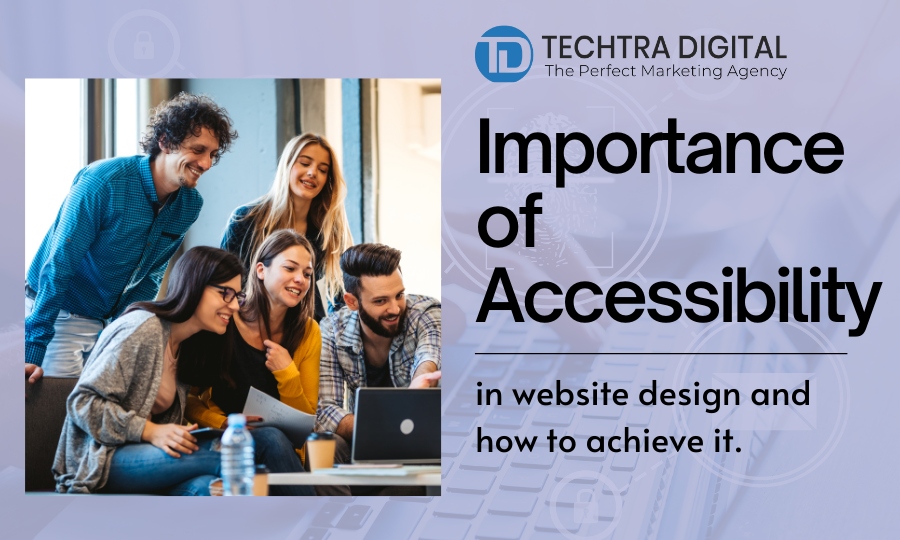Web accessibility is a recommended best practice that is frequently disregarded, regardless of whether you develop websites yourself or hire someone else to do it for you. Did you know that 1 in 200 women and 1 in 12 men are colorblind, according to the Color Blind Awareness Organization? Or that 1 in 4 adults living in the United States has a disability, according to the CDC? Now that you’ve seen your present website, you might be considering whether you need to upgrade it to comply with WCAG 2.1 accessibility standards. I’ll go over the reasons why making websites accessible is not just the moral thing to do, but also a good design practice, in this essay.
What Is Website Accessibility?
The practice of creating websites that are usable by individuals with disabilities is known as “website accessibility.” Accessing the internet can be difficult for people with disabilities for several reasons, including mobility, hearing, and vision problems. It is important to make websites accessible so that users of all abilities can access them.
Who uses accessible websites?
There is a misperception that only those with disabilities should care about web accessibility. But whether or not they realize it, everyone gains from more inclusive and accessible web design, as you can see from the examples of features above.
Other groups that take advantage of accessible features include, for instance:
Those who are momentarily unable
residents in rural places with poorer internet speeds
Senior citizens
Individuals in emerging nations
The use of web accessibility features can help everyone.
Consider this
How many of your site’s visitors won’t be able to interact with it if it doesn’t include accessibility features? Or stop using your website altogether because they had a bad experience with it?
Your website may be excluding potential consumers or customers if it is not accessible.
Why Is Accessibility on Websites Important?
Accessibility of websites is crucial for a number of reasons. First of all, it guarantees that those who are disabled can access the same knowledge and services as those who are not. This is crucial for developing a more welcoming and fair online environment. Furthermore, accessibility can enhance the user experience for everyone, even those who do not have disabilities. For instance, making your website more accessible can enhance its usability, boost its SEO, and even improve the reputation of your company.
How Can You Make Your Site More Accessible?
Use Descriptive Headings
The use of descriptive headers is crucial for making websites accessible. All users will find it easier to navigate a website with the help of headings that help organize the content. It’s important to utilize wording that appropriately describes the section’s content when constructing headings. This benefits user who use screen readers and are blind or visually challenged, as well as users who are cognitively handicapped or unfamiliar with the site’s content. You may enhance the user experience and increase the accessibility of your site by utilizing descriptive headings.
Use Alt Text for Images
A crucial component of website accessibility is alt text. It’s a description of an image that makes it possible for individuals with vision problems to comprehend its meaning. It’s crucial to include descriptive alt text when uploading photographs to your website. This will aid viewers who are visually challenged in understanding the content of the image. By doing this, you can make sure that everyone can visit your website, and you can foster a more welcoming online community.
Provide Transcripts For Audio And Video Content
Transcripts for audio and video content should always be available. This improves website accessibility. It is crucial to provide a textual transcript of the content since those with hearing problems may have trouble accessing audio or video content. This makes sure that everyone can access the information offered in the audio or video, regardless of hearing capacity. By offering transcripts, you foster a more welcoming online community and increase site accessibility for all users.
Use High-Contrast Colors
Colors with a high contrast ratio are essential for website accessibility. By clearly separating the text from the background, it makes it simpler for users with vision problems to read the content on your website. Make sure that the text and background colors contrast well enough to prevent making it difficult for people who have visual impairments to read. You may improve everyone’s access to your website, including those with visual impairments, by utilizing high-contrast colours.
Ensure That Your Site Is Keyboard Accessible
For a website to be accessible, the keyboard must be accessible. Some users with mobility issues might navigate your website using a keyboard rather than a mouse. The navigation of your website must therefore be possible just by using a keyboard. This includes making sure that all interactive elements are keyboard-accessible and using the “tab” key to switch between links and forms. You may offer a more inclusive online experience for all visitors, irrespective of their physical capabilities, by making your website keyboard accessible.
Use Clear And Simple Language
The use of simple, understandable language is a crucial aspect of website accessibility. It makes your website more accessible to those with cognitive impairments who might have problems deciphering technical language or jargon. To promote accessibility, avoid using jargon or technical phrases in favor of straightforward language that is easy to read and understand. By utilizing simple and plain language, you can ensure that anyone, regardless of cognitive capacity, can access your website.
An essential component of online design and development is website accessibility. You can make sure that everyone can access the information and services you offer by improving the accessibility of your website. Including accessibility features not only help those who have disabilities but also enhances the overall user experience.




